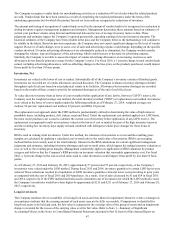Albertsons 2016 Annual Report Download - page 51
Download and view the complete annual report
Please find page 51 of the 2016 Albertsons annual report below. You can navigate through the pages in the report by either clicking on the pages listed below, or by using the keyword search tool below to find specific information within the annual report.49
The Company’s net reserve for closed properties was $29, net of estimated sublease recoveries of $19, as of February 27, 2016,
and $34, net of estimated sublease recoveries of $22, as of February 28, 2015.
Goodwill
Goodwill is tested at least annually for impairment and more frequently if events or changes in circumstances indicate that the
asset might be impaired. The impairment test is performed using a two-step process. In the first step, the fair value of each
reporting unit is compared with the carrying amount of the reporting unit, including goodwill. If the estimated fair value is less
than the carrying amount of the reporting unit, there is an indication that goodwill impairment exists and a second step is
completed in order to determine the amount of the goodwill impairment, if any, that should be recorded. In the second step, an
impairment loss is recognized for any excess of the carrying amount of the reporting unit’s goodwill over the implied fair value
of that goodwill.
The Company’s determination of reporting units considers the quantitative and qualitative characteristics of aggregation of each
of the components within the Wholesale and Retail operating segments. The significant qualitative and economic
characteristics used in determining our components to support their aggregation include types of businesses and the manner in
which the components operate, consideration of key impacts to net sales, cost of sales, competitive risks and the extent to
which components share assets and other resources. For Wholesale and Retail, the Company’s reporting units are the operating
segments of the business, which consist of Wholesale and Retail. Goodwill was assigned to these reporting units as of the
acquisition date, with no amounts being allocated between reporting units. For Save-A-Lot, the reporting units are the
components of the business: Licensee Distribution and Corporate Stores. Goodwill has been allocated between the Save-A-Lot
reporting units on a relative fair value basis.
The Wholesale reporting unit is comprised of the aggregation of two geographic distribution areas, which are organized based
on region components: East and West. The Company’s Retail reporting unit is comprised of the aggregation of five traditional
retail food store components under five banners: Cub Foods, Shoppers Food & Pharmacy, Shop 'n Save, Farm Fresh and
Hornbacher’s.
The fair values of the Company’s reporting units are determined by using both the market approach, applying a multiple of
earnings and revenue based on guidelines for publicly traded companies, and the income approach, discounting projected future
cash flows based on management’s expectations of the current and future operating environment. The rates used to discount
projected future cash flows reflect a weighted average cost of capital based on the Company’s industry, capital structure and
risk premiums including those reflected in the current market capitalization.
Fair value calculations contain significant judgments and estimates related to each reporting unit’s projected weighted average
cost of capital, future revenue, profitability, cash flows and fair values of assets and liabilities. When preparing these estimates,
management considers each reporting unit’s historical results, current operating trends and specific plans in place. These
estimates are impacted by variable factors, including inflation, the general health of the economy and market competition. The
Company has sufficient current and historical information available to support its judgments and estimates. However, if actual
results are not consistent with the Company’s estimates, future operating results may be materially impacted.
The Company performed its annual test of goodwill during the fourth quarter of fiscal 2016, utilizing discount rates ranging
between 10 percent and 13 percent to discount projected future cash flows for each reporting unit and perpetual growth rates
that ranged between 2 percent and 3 percent.
Management performed sensitivity analyses on the fair values resulting from the discounted cash flow analysis utilizing
alternate assumptions that reflect reasonably possible changes to future assumptions. Based upon the Company’s analysis of the
Wholesale, Save-A-Lot and Retail reporting units, a 100 basis point increase in the discount rate utilized in the discounted cash
flow analysis would not have resulted in any reporting unit failing step one of the impairment test. Additionally, a 100 basis
point decrease in the estimated perpetual sales growth rates utilized in the discounted cash flow analysis would not have
resulted in any reporting unit failing the first step of the impairment tests. The fair values of the Company’s Retail, Wholesale
and Save-A-Lot Corporate Stores reporting units exceeded their carrying values by approximately 100 percent, 95 percent and
35 percent, respectively. The fair value of goodwill for the Company’s Save-A-Lot Licensee Distribution reporting unit was in
excess of 100 percent of its carrying value. If the Company’s stock price experiences a significant and sustained decline, or
other events or changes in circumstances, such as a material shortfall of operating results to plan, the Company would reassess
the fair value of the Company’s reporting units to their carrying value.
The Company completed step one of the annual goodwill impairment evaluation during the fourth quarter for fiscal 2016 and
2015 with each reporting unit’s fair value exceeding its carrying value. Accordingly, step two of the impairment analysis was
not required for fiscal 2016 and 2015.
























